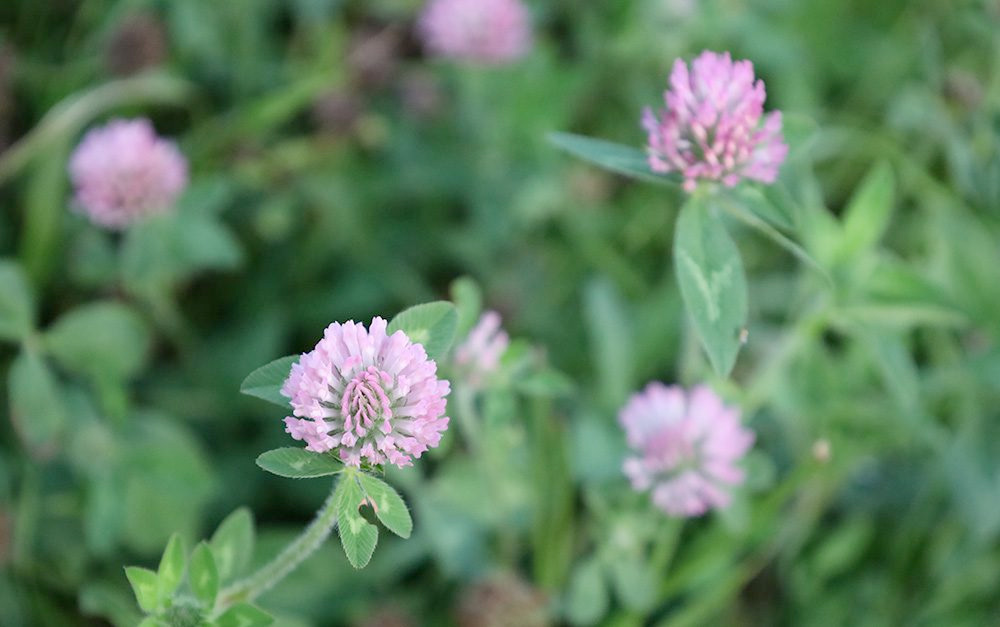23 Jun Supporting pollinators with lawn diversity
Pollinator Week happens once each year and I always hope to write one or two articles for PAN to get the word out that we can and must support our pollinators. But, as a steward of a small-scale, diversified farm, I can’t afford to think about pollinators for one week. I think about them year-round.
In late April and early May, the grassy areas on our farm were dotted purple with Common Violets, especially under the oak trees and by our smaller high tunnels (a hoop house where we grow vegetables). These little lawn jewels bloom longer in years when we aren’t having our ninth driest May on record. Seeing them got me thinking about how strange it is that we have allowed ourselves to be convinced that less life is better in the outdoor spaces around us, that a “well-maintained” lawn is preferable to a diverse landscape that provides food for our pollinators.
Clover, dandelions, and violets – oh my!
I remember spending a fair amount of time outside and on the ground when I was a kid so I could look at clover, dandelions and violets. My siblings and I even bought into the May Day idea of collecting some of the early spring flowers and putting them into baskets. The only difficulty was figuring out which houses would appreciate finding one of those little baskets at their door after we put them there, knocked – and ran away.
Not everyone saw the beauty in a small, sometimes bedraggled, bouquet of flowers. It’s kind of a shame that so many people didn’t, really.
Violets are an indicator of healthy diversity
If you were (or still are) one of those children who took some amount of delight in picking a few
Common Violets, you would know that each flower appears atop its own stem that comes from the top of the root ball. There are no leaves, or other flowers, that share the stem. This means they are perfect for miniature flower art projects.

Every so often, I have found violets that are white, which seems like a conflict of interest or something. Aren’t violets supposed to be . . . violet? Well it turns out that is true, except when they’re white, or maybe
even yellow. While yellow violets are a different species, the Common Violet can sometimes have white coloration. We had a couple of plants that featured mostly white flowers down by the high tunnel last year, but I did not see them this year.
Yes, I noticed that they weren’t there. Yes, I went looking for them. And, yes, I missed them.
Some people herald violets for their potential as
a foraged food in natural landscapes. Both the leaves and flowers are edible, though I will admit that I prefer observing them to eating them myself. On the other hand, there is another camp that sees violets as a nasty weed to be controlled. After all, you wouldn’t want a slightly different texture and a little color to become part of our urban landscape!
At least some lawn care sites provide a little balance, citing the Common Violet’s beauty and potential as a food item – before telling you how to kill them with herbicides.
Dandelions welcome
Perhaps you don’t think it’s odd to look for violets, but you do think I am at least a little strange for enjoying a nice, healthy bloom of dandelions. But maybe you would change your mind if you noticed the bumblebees bumbling their way around the flowers during their early season flights.

Isn’t it strange how we have somehow decided that clover, dandelions and violets are all undesirables in our lawns and grassy areas? It is documented that
Europeans brought dandelions with them as both a food and medicine. Some sources make the claim that dandelions were introduced to North America by the Puritans in the 1600s, though the actual introduction to the continent
is a bit less certain.
We wanted dandelions in our lives until we started listening to the sales pitch that they should be killed. Especially if we spent the money for products promoted by the pesticide and synthetic herbicide industries.
From a soil health perspective, we like the way the deep taproots of the dandelion loosen and aerate the soil. We feel that these same roots bring nutrients up from deeper soil layers so they can be used by other plants. And, because they draw most of their moisture and food from a deeper soil layer, they often don’t compete with our food crops, so they aren’t a bad weed for a vegetable farm.
We can relearn that clover isn’t bad
And then there is the clover. Prior to the 1960s, clover was a regular part of lawn seed mixes until the herbicide industry began selling the idea that grass, and only one kind of grass, should be welcome in a “well-maintained” lawn. I still remember that barefoot children always took note of where the clover was so they didn’t accidentally step on a bee and get stung! Now, barefoot children stay off the lawn because it’s been recently sprayed with pesticides.
Give me more clover, more violets and even more dandelions. Certainly, there will be places on our farm where we remove some in favor of other plants. But as far as weeds go, these three are our friends. And, they, along with other flowering plants, provide a long season of food for our pollinators.

 Every so often, I have found violets that are white, which seems like a conflict of interest or something. Aren’t violets supposed to be . . . violet? Well it turns out that is true, except when they’re white, or maybe even yellow. While yellow violets are a different species, the Common Violet can sometimes have white coloration. We had a couple of plants that featured mostly white flowers down by the high tunnel last year, but I did not see them this year.
Yes, I noticed that they weren’t there. Yes, I went looking for them. And, yes, I missed them.
Some people herald violets for their potential as a foraged food in natural landscapes. Both the leaves and flowers are edible, though I will admit that I prefer observing them to eating them myself. On the other hand, there is another camp that sees violets as a nasty weed to be controlled. After all, you wouldn’t want a slightly different texture and a little color to become part of our urban landscape!
At least some lawn care sites provide a little balance, citing the Common Violet’s beauty and potential as a food item – before telling you how to kill them with herbicides.
Every so often, I have found violets that are white, which seems like a conflict of interest or something. Aren’t violets supposed to be . . . violet? Well it turns out that is true, except when they’re white, or maybe even yellow. While yellow violets are a different species, the Common Violet can sometimes have white coloration. We had a couple of plants that featured mostly white flowers down by the high tunnel last year, but I did not see them this year.
Yes, I noticed that they weren’t there. Yes, I went looking for them. And, yes, I missed them.
Some people herald violets for their potential as a foraged food in natural landscapes. Both the leaves and flowers are edible, though I will admit that I prefer observing them to eating them myself. On the other hand, there is another camp that sees violets as a nasty weed to be controlled. After all, you wouldn’t want a slightly different texture and a little color to become part of our urban landscape!
At least some lawn care sites provide a little balance, citing the Common Violet’s beauty and potential as a food item – before telling you how to kill them with herbicides.
 Isn’t it strange how we have somehow decided that clover, dandelions and violets are all undesirables in our lawns and grassy areas? It is documented that Europeans brought dandelions with them as both a food and medicine. Some sources make the claim that dandelions were introduced to North America by the Puritans in the 1600s, though the actual introduction to the continent is a bit less certain.
We wanted dandelions in our lives until we started listening to the sales pitch that they should be killed. Especially if we spent the money for products promoted by the pesticide and synthetic herbicide industries.
From a soil health perspective, we like the way the deep taproots of the dandelion loosen and aerate the soil. We feel that these same roots bring nutrients up from deeper soil layers so they can be used by other plants. And, because they draw most of their moisture and food from a deeper soil layer, they often don’t compete with our food crops, so they aren’t a bad weed for a vegetable farm.
Isn’t it strange how we have somehow decided that clover, dandelions and violets are all undesirables in our lawns and grassy areas? It is documented that Europeans brought dandelions with them as both a food and medicine. Some sources make the claim that dandelions were introduced to North America by the Puritans in the 1600s, though the actual introduction to the continent is a bit less certain.
We wanted dandelions in our lives until we started listening to the sales pitch that they should be killed. Especially if we spent the money for products promoted by the pesticide and synthetic herbicide industries.
From a soil health perspective, we like the way the deep taproots of the dandelion loosen and aerate the soil. We feel that these same roots bring nutrients up from deeper soil layers so they can be used by other plants. And, because they draw most of their moisture and food from a deeper soil layer, they often don’t compete with our food crops, so they aren’t a bad weed for a vegetable farm.

